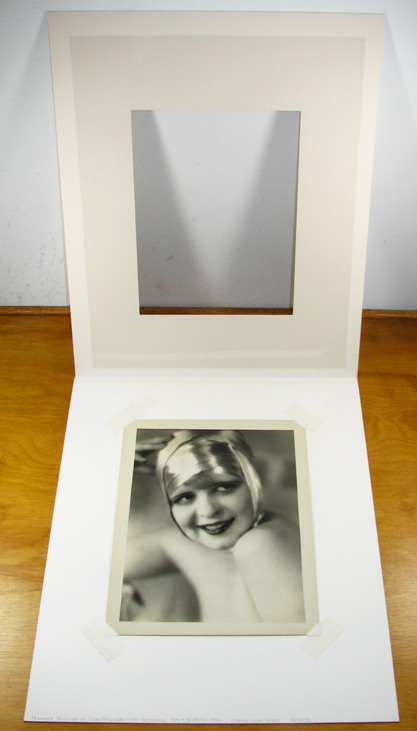 |
| Above: Full view of photograph |
 |
| Above: Tipped on to matt |
A spectacular 1929 image of Clara Bow from the pinnacle of her it girl stardom in a wild jazz age headscarf with streamlined modernist style, by George Hommel. Bow’s wizened eyes and cupid feature captured the nihilism and eroticism of the Lost generation, as well as the heart of the American moviegoing public, and vintage original stills of her remain highly collectible.
 |
| Above: Matted view |
 |
| Above: Detail of Clara Bow |
Biography by All Movie Guide
Famous as the “It” girl of the Roaring 20s; Clara Bow was the flapper to end all flappers. The daughter of a Coney Island waiter, she spent her youth in poverty. At 16 she won a movie magazine beauty contest; part of the prize was a trip to visit the New York studios and a bit part in a silent, soon leading to other roles mostly in low-budget films. Under contract to producer B.P. Schulberg, she went with Schulberg from New York to Hollywood’s Paramount, where the studio’s publicity machine helped mold her into a star, particularly after Mantrap (1926), her first smash hit. Soon she became a symbol of the emancipated woman during the flapper age: vibrant, liberated, energetic. Her bobbed hair, bow lips, and sparkling eyes came to represent the era, and her bangled, beaded “look” soon became imitated by women throughout America. After appearing in the film It (1927) she became known as the “It” girl, a woman with “something extra” which set her apart from the common herd. While living the life of the Roaring 20s, however, she became the victim of numerous scandals and quickly fell from grace with the public (which in a 1928 poll had named her America’s favorite actress). With the advent of sound, her career ground to a halt. In 1931 she eloped with cowboy star Rex Bell, who eventually became lieutenant governor of Nevada. Bow retired from the screen in 1933.
 |
| Above: Blindstamp by Hommel |
 |
| Above: Inkstamp on verso |
